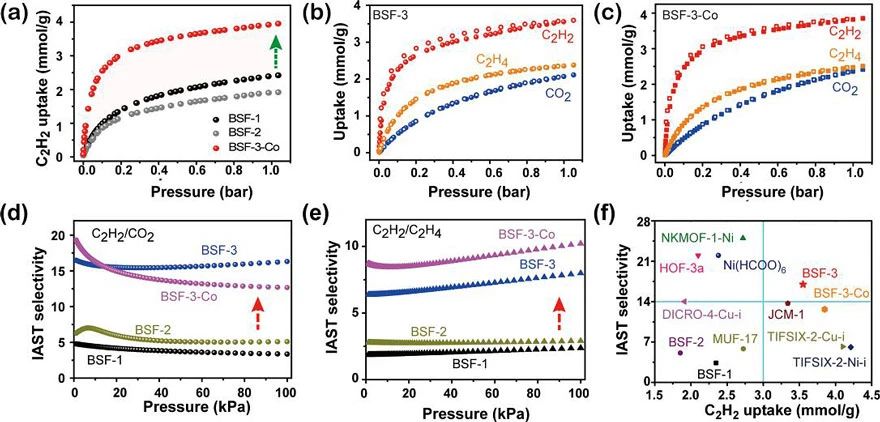
hotline:
17715390137
Tel/Wechat:
18101240246 (Technology)
0512-68565571
Email:mxenes@163.com (Sales Engineer)bkxc.bonnie@gmail.com
Scan the code to follow or search the official account on WeChat:
2D Materials Fronrier After paying attention,
click on the lower right corner to contact us,
Enter enterprise WeChat.
Professional Services Online

The high-efficiency separation of C2H2/CO2 and C2H2/C2H4 has important research significance and industrial value. The adsorbent materials currently used to separate C2H2/CO2 and C2H2/C2H4 are generally based on unsaturated metal sites, strong hydrogen bonds or strong electrostatic interactions. The site has the defect that it is difficult to have both selectivity and capacity. The caged icosahedral dodecane borane anion [B12H12] 2-is a stable structure constructed from 12 identical B-H vertices. Due to its local delocalization of negative charge, the 3D analogue, usually called a benzene ring, has σ aromaticity. Theoretical calculations show that the negative hydrogen (B-Hδ-) on the surface of the anion of the Bronze-dodecane boron cage can form a strong dihydrogen bond with the C2H2 molecule (B-Hδ-•••Hδ+-C), and the binding energy is 40.2 kJ/ mol; and the interaction with CO2 (28.5 mol/kJ) and C2H4 (25.6 mol/kJ) is weaker.
Figure 1. Binding energy of [B12H12]2- and C2H2, CO2, C2H4 calculated by DFT

Based on the shape difference of C2H2, CO2 and C2H4 molecules, Professors Xing Huabin and Simon Duttwyler of Zhejiang University optimized the structure of bipyridine ligands by introducing borane anions as functional binding sites, and obtained two suitable pore size MOF materials BSF -3 and BSF-3-Co. The crystal structure of BSF-3 indicates that the two opposite anion boron cages are at a moderate distance and can form a synergistic dihydrogen bond with the hydrogen at the two ends of the acetylene molecule (B-Hδ-•••Hδ+-C≡C-Hδ+• ••Hδ--B). DFT calculations show that the binding energy caused by the synergistic dihydrogen bond can be as high as 48.8kJ/mol, which can firmly lock the acetylene molecules in the pores and enhance the selectivity of acetylene to ethylene or carbon dioxide.
Figure 2. Schematic diagram of the synergistic dihydrogen bonding between two [B12H12]2-anions and C2H2

Figure 3. Structure of boron cage anionic hybrid supramolecular metal frame material BSF-3

Static adsorption experiments show that the adsorption capacity of C2H2, CO2 and C2H4 in BSF-3 is 3.59/2.11/2.37 mmol/g3, and the adsorption capacity in BSF-3-Co is 3.85/2.41/2.51mmol/g. The selectivity of C2H2/CO2 and C2H2/C2H4 calculated by the ideal solution model is 16.3/8.0 (BSF-3) and 12.7/10.2 (BSF-3), which is higher than most of the materials reported so far. The mixed gas penetration test further proves that BSF-3 has excellent separation performance and cycle performance of C2H2/CO2 and C2H2/C2H4.

Figure 4. (a) Acetylene adsorption isotherms of BSF-1, BSF-2 and BSF-3 at 298 K; (b, c) C2H2, CO2 and BSF-3 and BSF-3-Co at 298 K Adsorption isotherms of C2H4; (d, e) IAST separation selectivity of C2H2/CO2 and C2H2/C2H4 of BSF-3 and BSF-3-Co; (f) Comparison of C2H2/CO2 separation performance of representative materials.
The related work was published in Angew. Chem. Int. Ed. The first author of the article was Zhang Yuanbin, a postdoctoral fellow at Zhejiang University. The theoretical calculation work was mainly completed by Hu Jianbo, a postdoctoral fellow at Zhejiang University.
Original text (scan or long press the QR code to go directly to the original page after recognition):
Rational design of microporous MOFs with anionic boron cluster functionality and cooperative dihydrogen binding sites for highly selective capture of acetylene
Yuanbin Zhang, Jianbo Hu, Rajamani Krishna, Lingyao Wang, Lifeng Yang, Xili Cui, Simon Duttwyler, Huabin Xing
Angew. Chem. Int. Ed., 2020, DOI: 10.1002/anie.202007681
Research team introduction
The Research Group of Low Carbon Hydrocarbon and Drug Separation in the School of Chemical Engineering and Bioengineering of Zhejiang University has long been engaged in the research of advanced separation materials and separation engineering, and the manufacture of high-purity chemicals. In recent years, it has published more than 150 academic papers in Science, Science Advances and other journals He has won the second prize of National Technology Invention Award, the 100 most influential academic papers in China, the first prize of Zhejiang Science and Technology Progress Award, and the Outstanding Contribution Award of Youth Science and Technology of China Petrochemical Federation. Due to the needs of scientific research work, the research team invites 2-3 postdoctors sincerely, especially welcomes the molecular sieve and polymer research experience!
https://www.x-mol.com/university/faculty/21729
This information originates from the Internet for academic exchange only. If there is any infringement, please contact us to delete it

| Reminder: Beijing Beike New Material Technology Co., Ltd. supplies products only for scientific research, not for humans |
| All rights reserved © 2019 beijing beike new material Technology Co., Ltd 京ICP备16054715-2号 |